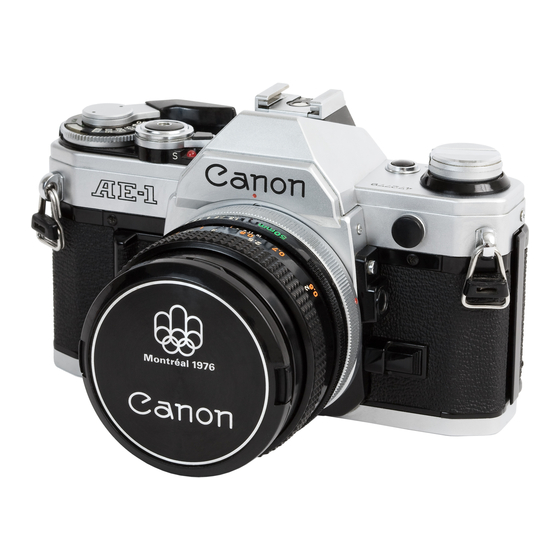Canon AE-1 매뉴얼 - 페이지 3
{카테고리_이름} Canon AE-1에 대한 매뉴얼을 온라인으로 검색하거나 PDF를 다운로드하세요. Canon AE-1 42 페이지.
Canon AE-1에 대해서도 마찬가지입니다: 시작하기 (2 페이지), 사용 설명서 (22 페이지), 설치 절차 매뉴얼 (48 페이지), 매뉴얼 (12 페이지), 사용 설명서 (22 페이지)

operation.
4. Electromagnetic Shutter Release Button
Activated by a Very Smooth Touch. Two-step shutter button. Light metering is activated by
the halfway depression and shutter release by the further depression.
5. Immediate Response Metering. Light metering takes only 0.001 sec. at EV 12.
6. Shutter Speed Priority AE Camera.
High mobility. Less chance of camera shake. Effective for fast breaking action.
7. Compact and Lightweight Design.
590g (20-13/16 ozs.) body only. 790g (27-7/8 ozs.) with the 50mm f/1.8 S.C. Iens. 895g (31-
9/16 ozs.) with the 50mm f/1.4 S.S.C. Iens.
8. Design Based on Human Engineering Technique.
Rounded back contours and large operational parts that fit to hand. Finger grip bar. Film
advance with 120° throw. One finger operation.
9. Other Features.
Interchangeable back cover.
Memo holder.
Backlight control switch.
Electronic self-timer.
All these were packed in a economical price range - it is an entirely new kind of SLR camera
during that time. Canon AE-1 was massed produced with new manufacturing and assembling
techniques even though it had made its debut during an economic slump. The high degree of
automation was not been restricted only to the camera. It was extended to the various
accessories, all with the same standard of precision. The AE-1 was also the first camera to
offer a totally automated electronic photographic system. It takes its name, AE-1 (Automatic
Exposure-One), from this concept.
Application of Electronics is the Cornerstone of the Entire Design Automation in the AE-
1 was made possible by the application of the 'most advanced' available electronic
technologies during the seventies (Although it may sound pretty much outdated when
compared with today's electronics standard), and after a thorough analysis of all the
mechanisms and their operations. The important mechanical features made way for the
electronic ones, thus changing the very essence of the camera's design.
As a result, a miniature computer (CPU) was successfully incorporated in the AE-1 for the
first time in the world to compute, judge, control, display and regulate required information -
in certain ways, unmatched by mechanical mechanism especially where the precise timing of
the shutter speeds and electronic flash compatibility.
The (Integrated Injection Logic), as far as its application in photography is concerned, was the
most outstanding achievement in the field of electronics during the early and mid-'70s. An
But up to the mid-'70s, electronics control and applications
in SLR cameras were still limited, for example, where the
mechanical designs were largely responsible for much of the
operations. But the AE-1 was the first camera in the world
to incorporate a CPU (Central Processing Unit) which
enabled automatic exposure, memory transmission of
signals, display, regulation of time and completion signal
are all electronically controlled.
